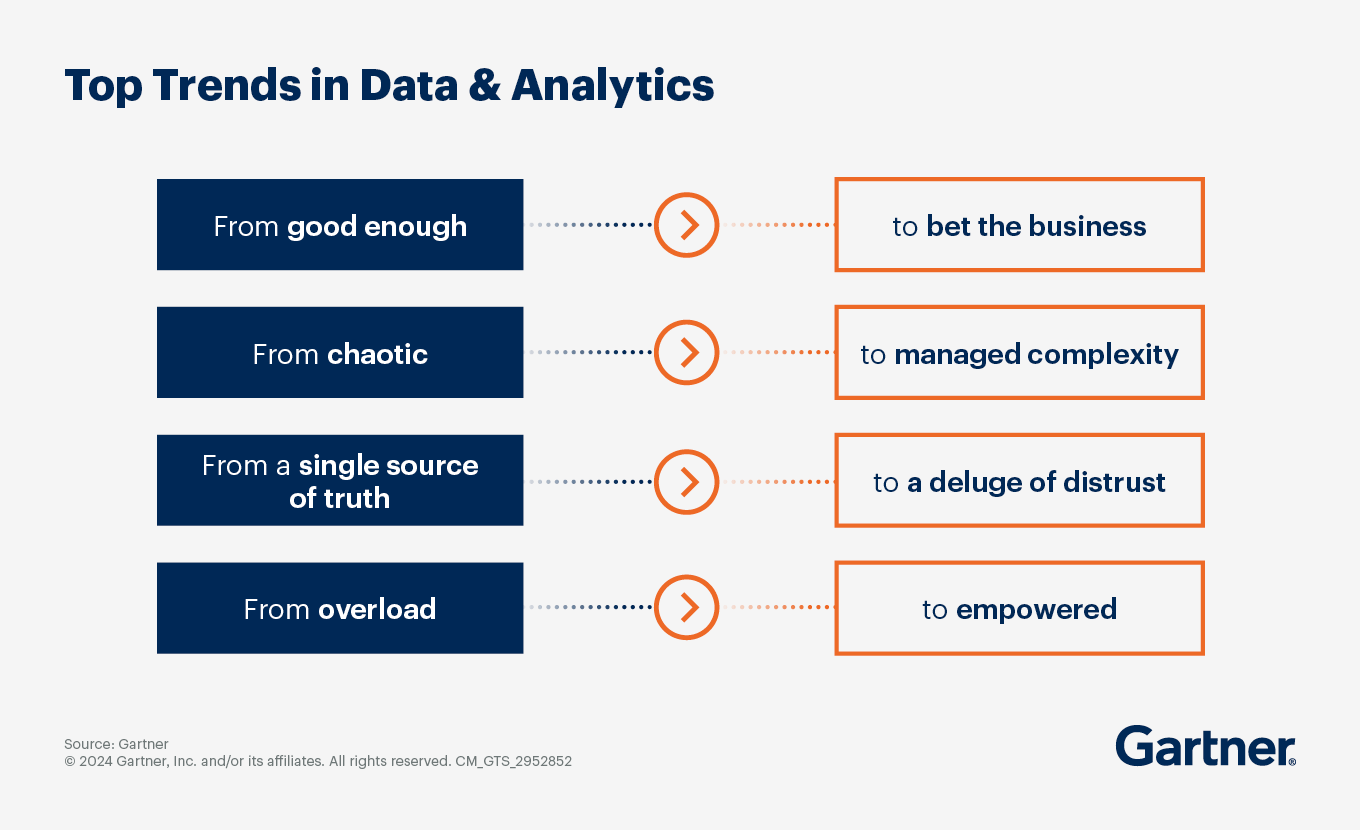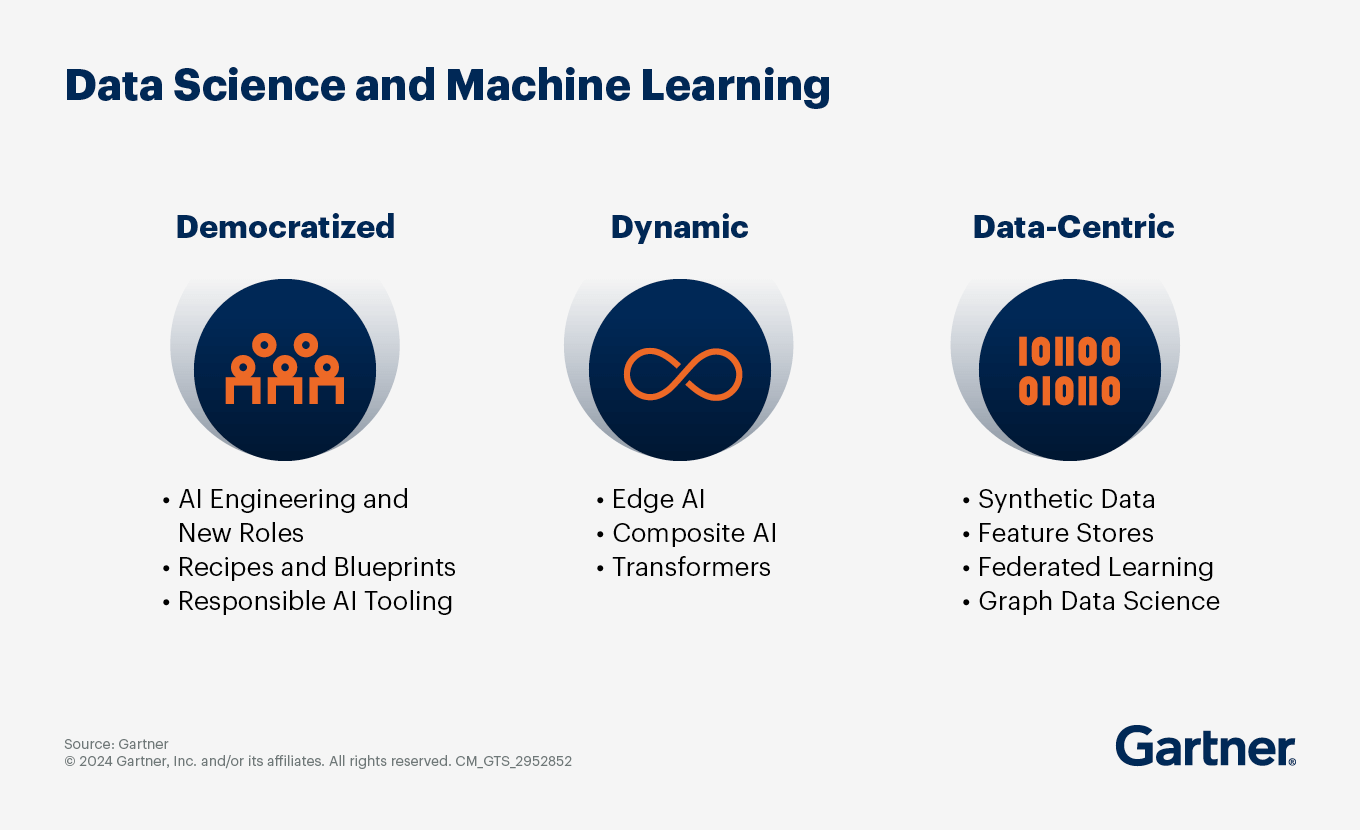CDAOs that respond proactively to top D&A trends help their organization make value-driving business decisions faster.
- Gartner client? Log in for personalized search results.
Top Trends in Data & Analytics (D&A)
Anticipating data and analytics trends is critical to CDAOs’ strategic planning
A key mandate for every D&A leader is to identify which data and analytics innovations and capabilities will help them drive greater tangible outcomes for key business stakeholders.
Strategic planning assumptions are key to those decisions. Use “Over 100 Data and Analytics Predictions Through 2030” to help you identify, understand and plan for change.
This report includes key data trends in key areas, such as:
Core data and analytics, and AI
Digital business
Industry segments
Scoping a range of D&A trends is key for CDAO strategic planning
CDAOs must plan for various future scenarios to ensure the D&A function continues to drive tangible business value. Use D&A trends to develop the strategic assumptions you need.
Top 4 Data Trends
AI Trends for D&A
D&A Governance Trends
Enable your organization to anticipate change, make decisions and enhance efficiency.
Today’s D&A leaders are under immense pressure to monitor and incorporate new technologies while maintaining existing data platforms and educating colleagues.
To align technology and organizational requirements in a way that effectively drives strategy, make sure to respond proactively to key trends, including these four:
D&A trend 1: From good enough to bet-the-business
AI has become a bet-the-business skill set. The power of AI and the visibility of generative AI (GenAI) are changing how individuals work, teams collaborate and processes run. At a strategic level, AI is transforming industries and has become a board-level issue that will define the success or failure of an organization.
D&A trend 2: From chaotic to managed complexity
Chaos can be overwhelming; one problem sparks another, which sparks two more — and this leads to an avalanche of failures and problems. Leading organizations use data and analytics as the tools to turn chaos into complexity. Complexity is not easy, but it offers a more realistic understanding of the changes sweeping the data and analytics ecosystem and the business to deliver better outcomes.
D&A trend 3: From a single source of truth to a deluge of distrust
With the medallion approach, purpose-built data stores in data management and persistence in analytics and AI tools, organizations have moved beyond a single source of truth. But not all data is good data. Whether data is purposely malicious or just inaccurate or incomplete, it can’t all be trusted. As GenAI continues to grow in accessibility and performance, D&A teams must operate in a world where the ”language” of trustable, accurate data is continually called into question.
D&A trend 4: From overloaded to empowered
To reduce overall workload and stress, D&A leaders must create empowered individuals and teams. Engage with stakeholders, teams, partners and colleagues across the organization to make them more powerful and productive. All employees should be able to use data and analytics to drive innovation, but people need to trust the data and feel empowered to use it to challenge the status quo.
3 critical trends in data science and machine learning
Data science and machine language (DSML) platforms represent a rapidly evolving area of technology and D&A leaders must understand the key trends influencing those spheres to better visualize their potential capabilities. Key ML and data science trends fall into three main groups — representing the endeavors that will take organizations into the future:
Democratization: The DSML platform is suitable for everyone — not just data scientists, but business users, analysts and software engineers.
AI engineering and new roles: Democratize DSML and AI across technical roles. The compound skills of various skills unlocks more business value.
Recipes and blueprints: Blur the line between software and custom code and allow reuse of what the experts have already figured out.
Responsible AI tooling: Instill user trust and stakeholder accountability via automated development and monitoring milestones and a detailed record of all actions on models.
Dynamism: Solutions are accessible anywhere and use composable data science techniques and new algorithms.
Edge AI: Use AI techniques embedded in Internet of Things (IoT) endpoints, gateways and edge servers in applications ranging from autonomous vehicles to streaming analytics.
Composite AI: Combine the power of different techniques in practical solutions. It adds common sense to accelerate the effectiveness of data science.
Transformers (foundation models): Embody a type of deep neural network architecture that computes a numerical representation of artifacts in the context of surrounding artifacts, emphasizing sequences, such as large language models.
Data-centricity: The outcome of AI solutions is driven more by enhancing and enriching data than by model tuning.
- Synthetic data: Relieve the burden of obtaining real-world data and labeling it so that ML models can be trained effectively.
- Feature stores: Build to address the need for feature reusability, reproducibility and reliability in ML portfolios.
- Federated learning: Accelerate model development while protecting privacy.
- Graph data science: Solve complex problems where network effects and relationships cannot be easily modeled using tabular data, but are often better indicators of predicting an outcome.
Utilize new technology capabilities for effective D&A governance.
Digital business requires an agile, flexible and adaptive governance approach. The needs of data and analytics governance have never been centralized and consolidated, but siloed solutions were often the only tools employed in the data management plane.
Without a data and analytics governance plan that reflects the realities of digital business, critical operations will function poorly or fail. This will lead to significant and lasting damage to the organization.
Data and analytics leaders will face complex challenges surrounding governance. Gartner recommends three key actions:
- Approach D&A governance as a holistic discipline, by using an adaptive framework that enables the application of different governance styles to suit the context of various business scenarios.
- Design and build proofs of concept that will capitalize on the required critical technology capabilities. Identify the relevance of these technologies and their connection to business outcomes as a first step. Then look into their ability to support specific use cases such as risk management and compliance.
- Minimize the number of tools and solutions deployed by analyzing your strategic approach to data and analytics governance and by using available market technology capabilities in end-to-end scenarios.
Experience Data and Analytics conferences
Join your peers for the unveiling of the latest insights at Gartner conferences.
Frequently asked questions about D&A trends
What are the top trends in data in 2024?
Gartner identifies four key trends for data and analytics:
- Organizations must acknowledge the importance of D&A and use technologies like GenAI to act successfully on industry transformations.
- Chaos can be overwhelming; leading organizations are working to turn chaos into managed complexity.
- While we all love the idea of a single source of truth for data, organizations must continuously manage inaccurate, incomplete and bad sources of data.
- The pace and complexity of modern business overwhelms individuals, but organizations can foster their success and give them the skills to be superheroes.




